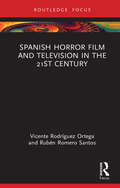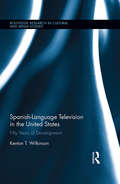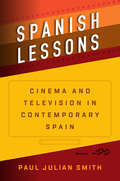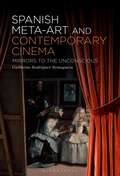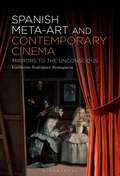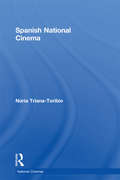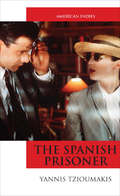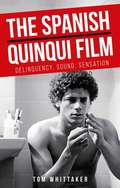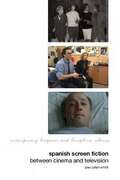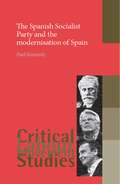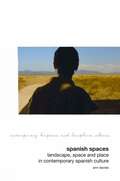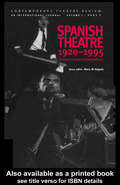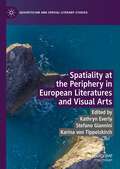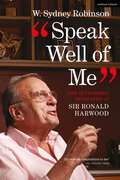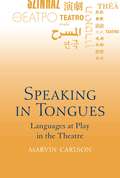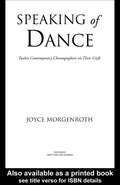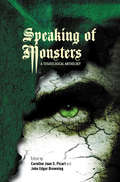- Table View
- List View
Spanish Horror Film and Television in the 21st Century (Routledge Focus on Media and Cultural Studies)
by Vicente Rodríguez Ortega Rubén Romero SantosThis book provides an up-to-date, in-depth survey of 21st-century Spanish horror film and media, exploring both aesthetics and industrial dynamics. It offers detailed analysis of contemporary films and TV series as well as novel approaches to key works within the history of Spanish cinema. While addressing the specificities of the Spanish landscape, this volume also situates the national cinematic output within the international arena, understanding film production and reception as continuously changing processes in which a variety of economic, social and cultural factors intervene. The book first analyzes the main horror trends emerging in the early 2000s, then approaches genre hybridization and the rise of new filmmakers since the 2010s with a special focus on gender issues and the reconfiguration of the past, before addressing the impact of streaming services within the Spanish film panorama, from a production and distribution standpoint. This book will be of keen interest to scholars and students in the areas of film studies, media studies, TV studies, horror, Spanish cultural studies and production studies.
Spanish Horror Film and Television in the 21st Century (Routledge Focus on Media and Cultural Studies)
by Vicente Rodríguez Ortega Rubén Romero SantosThis book provides an up-to-date, in-depth survey of 21st-century Spanish horror film and media, exploring both aesthetics and industrial dynamics. It offers detailed analysis of contemporary films and TV series as well as novel approaches to key works within the history of Spanish cinema. While addressing the specificities of the Spanish landscape, this volume also situates the national cinematic output within the international arena, understanding film production and reception as continuously changing processes in which a variety of economic, social and cultural factors intervene. The book first analyzes the main horror trends emerging in the early 2000s, then approaches genre hybridization and the rise of new filmmakers since the 2010s with a special focus on gender issues and the reconfiguration of the past, before addressing the impact of streaming services within the Spanish film panorama, from a production and distribution standpoint. This book will be of keen interest to scholars and students in the areas of film studies, media studies, TV studies, horror, Spanish cultural studies and production studies.
Spanish-Language Television in the United States: Fifty Years of Development (Routledge Research in Cultural and Media Studies)
by Kenton T. WilkinsonSince its introduction in the early 1960s, Spanish-language television in the United States has grown in step with the Hispanic population. Industry and demographic projections forecast rising influence through the 21st century. This book traces U.S. Spanish-language television’s development from the 1960s to 2013, illustrating how business, regulation, politics, demographics and technological change have interwoven during a half century of remarkable change for electronic media. Spanish-language media play key social, political and economic roles in U.S. society, connecting many Hispanics to their cultures of origin, each other, and broader U.S. society. Yet despite the population’s increasing impact on U.S. culture, in elections and through an estimated $1.3 trillion in spending power in 2014, this is the first comprehensive academic source dedicated to the medium and its history. The book combines information drawn from the business press and trade journals with industry reports and academic research to provide a balanced perspective on the origins, maturation and accelerated growth of a significant ethnic-oriented medium.
Spanish-Language Television in the United States: Fifty Years of Development (Routledge Research in Cultural and Media Studies)
by Kenton T. WilkinsonSince its introduction in the early 1960s, Spanish-language television in the United States has grown in step with the Hispanic population. Industry and demographic projections forecast rising influence through the 21st century. This book traces U.S. Spanish-language television’s development from the 1960s to 2013, illustrating how business, regulation, politics, demographics and technological change have interwoven during a half century of remarkable change for electronic media. Spanish-language media play key social, political and economic roles in U.S. society, connecting many Hispanics to their cultures of origin, each other, and broader U.S. society. Yet despite the population’s increasing impact on U.S. culture, in elections and through an estimated $1.3 trillion in spending power in 2014, this is the first comprehensive academic source dedicated to the medium and its history. The book combines information drawn from the business press and trade journals with industry reports and academic research to provide a balanced perspective on the origins, maturation and accelerated growth of a significant ethnic-oriented medium.
Spanish Lessons: Cinema and Television in Contemporary Spain
by Paul Julian SmithThough unjustly neglected by English-language audiences, Spanish film and television not only represent a remarkably influential and vibrant cultural industry; they are also a fertile site of innovation in the production of “transmedia” works that bridge narrative forms. In Spanish Lessons, Paul Julian Smith provides an engaging exploration of visual culture in an era of collapsing genre boundaries, accelerating technological change, and political-economic tumult. Whether generating new insights into the work of key figures like Pedro Almodóvar, comparing media depictions of Spain’s economic woes, or giving long-overdue critical attention to quality television series, Smith’s book is a consistently lively and accessible cultural investigation.
Spanish Meta-Art and Contemporary Cinema: Mirrors to the Unconscious
by Guillermo Rodríguez-RomagueraCan cinema reveal its audience's most subversive thinking? Do films have the potential to project their viewers' innermost thoughts making them apparent on the screen? This book argues that cinema has precisely this power, to unveil to the spectator their own hidden thoughts. It examines case studies from various cultures in conversation with Spain, a country whose enduring masterpieces in self-reflexive or meta-art provide insight into the special dynamic between viewer and screen. Framed around critical readings of Miguel de Cervantes' Don Quixote, Diego Velázquez' Las meninas and Luis Buñuel's Un chien andalou, this book examines contemporary films by Víctor Erice, Carlos Saura, Bigas Luna, Alejandro Amenábar, Lucrecia Martel, Krzysztof Kieslowski, David Lynch, Pedro Almodóvar, Spike Jonze, Andrzej Zulawski, Fernando Pérez, Alfred Hitchcock, Wes Craven and David Cronenberg to illustrate how self-reflexivity in film unbridles the mental repression of film spectators. It proposes cinema as an uncanny duplication of the workings of the brain – a doppelgänger to human thought.
Spanish Meta-Art and Contemporary Cinema: Mirrors to the Unconscious
by Guillermo Rodríguez-RomagueraCan cinema reveal its audience's most subversive thinking? Do films have the potential to project their viewers' innermost thoughts making them apparent on the screen? This book argues that cinema has precisely this power, to unveil to the spectator their own hidden thoughts. It examines case studies from various cultures in conversation with Spain, a country whose enduring masterpieces in self-reflexive or meta-art provide insight into the special dynamic between viewer and screen. Framed around critical readings of Miguel de Cervantes' Don Quixote, Diego Velázquez' Las meninas and Luis Buñuel's Un chien andalou, this book examines contemporary films by Víctor Erice, Carlos Saura, Bigas Luna, Alejandro Amenábar, Lucrecia Martel, Krzysztof Kieslowski, David Lynch, Pedro Almodóvar, Spike Jonze, Andrzej Zulawski, Fernando Pérez, Alfred Hitchcock, Wes Craven and David Cronenberg to illustrate how self-reflexivity in film unbridles the mental repression of film spectators. It proposes cinema as an uncanny duplication of the workings of the brain – a doppelgänger to human thought.
Spanish National Cinema (National Cinemas)
by Nuria Triana-ToribioThis study examines the discourses of nationalism as they intersected or clashed with Spanish film production from its inception to the present. While the book addresses the discourses around filmmakers such as Almodóvar and Medem, whose work has achieved international recognition, Spanish National Cinema is particularly novel in its treatment of a whole range of popular cinema rarely touched on in studies of Spanish cinema. Using accounts of films, popular film magazines and documents not readily available to an English-speaking audience, as well as case studies focusing on the key issues of each epoch, this volume illuminates the complex and changing relationship between cinema and Spanish national identity.
Spanish National Cinema (National Cinemas)
by Nuria Triana-ToribioThis study examines the discourses of nationalism as they intersected or clashed with Spanish film production from its inception to the present. While the book addresses the discourses around filmmakers such as Almodóvar and Medem, whose work has achieved international recognition, Spanish National Cinema is particularly novel in its treatment of a whole range of popular cinema rarely touched on in studies of Spanish cinema. Using accounts of films, popular film magazines and documents not readily available to an English-speaking audience, as well as case studies focusing on the key issues of each epoch, this volume illuminates the complex and changing relationship between cinema and Spanish national identity.
The Spanish Prisoner (American Indies)
by Yannis TzioumakisDespite more than a passing nod to such crowdpleasing classics as Hitchcock's North by Northwest, playwright-turned-independent filmmaker David Mamet's The Spanish Prisoner is a particularly idiosyncratic film that betrays its origin outside the Hollywood mainstream. Featuring a convoluted narrative, an excessive, often anti-classical, visual style, and belonging to the generic category of the'con game film' which often challenges the spectator's cognitive skills, The Spanish Prisoner is a film that bridges genre filmmaking withpersonal visual style, independent film production with niche distribution,and mainstream subject matter with unconventional filmic techniques.This book discusses The Spanish Prisoner as an example of contemporary American independent cinema while also using the film as a vehicle to explore several key ideas in film studies, especially in terms of aesthetics, narrative, style, spectatorship, genre and industry.Key FeaturesoDistinguishes between independent and 'indie' cinema through anexamination of the 'classics divisions,' especially Sony Pictures ClassicsoAssesses the position of David Mamet within American cinemaoIntroduces the genre categories of the 'con artist' and the 'con game' filmand discusses The Spanish Prisoner as a key example of the latteroExamines the ways in which narrative, narration and visual style deviatefrom the mainstream/classical aesthetic
The Spanish quinqui film: Delinquency, sound, sensation (Manchester University Press)
by Tom WhittakerThis is the first major study in English of cine quinqui, a cycle of popular Spanish films from the late 1970s and early 1980s that starred real-life juvenile delinquents. The book provides a close analysis of key quinqui films by directors such as Eloy de la Iglesia, José Antonio de la Loma and Carlos, as well as the moral panics, public fears and media debates that surrounded their controversial production and reception. In paying particular attention to the soundtrack of the films, the book shows how marginal youth cultures during Spain’s transition to democracy were shaped by sound. It will be of interest to scholars and students of Spanish film, history and cultural studies, and those working in sound studies and youth subcultures more broadly.
The Spanish quinqui film: Delinquency, sound, sensation (Manchester University Press)
by Tom WhittakerThis is the first major study in English of cine quinqui, a cycle of popular Spanish films from the late 1970s and early 1980s that starred real-life juvenile delinquents. The book provides a close analysis of key quinqui films by directors such as Eloy de la Iglesia, José Antonio de la Loma and Carlos, as well as the moral panics, public fears and media debates that surrounded their controversial production and reception. In paying particular attention to the soundtrack of the films, the book shows how marginal youth cultures during Spain’s transition to democracy were shaped by sound. It will be of interest to scholars and students of Spanish film, history and cultural studies, and those working in sound studies and youth subcultures more broadly.
Spanish Screen Fiction: Between Cinema and Television (Contemporary Hispanic and Lusophone Cultures #3)
by Paul SmithThis pioneering book is the first to argue that cinema and television in Spain only make sense when considered together as twin vehicles for screen fiction. The Spanish audiovisual sector is now one of the most successful in the world, with feature films achieving wider distribution in foreign markets than nations with better known cinematic traditions and newly innovative TV formats, already dominant at home, now widely exported. Beyond the industrial context, which has seen close convergence of the two media, this book also examines the textual evidence for crossover between cinema and television at the level of narrative and form. The book, which is of interest to both Hispanic and media studies, gives new readings of some well-known texts and discovers new or forgotten ones. For example it compares Almodóvar’s classic feature Mujeres al borde de un ataque de nervios (‘Women on the Verge of a Nervous Breakdown’) with his production company El Deseo’s first venture into TV production, the 2006 series also known as Mujeres (‘Women’). It also reclaims the lost history of female flat share comedy on Spanish TV from the 1960s to the present day. It examines a wide range of prize winning workplace drama on TV, from police shows, to hospital and legal series. Amenábar’s Mar adentro (‘The Sea Inside’) an Oscar-winning film on the theme of euthanasia, is contrasted with its antecedent, an episode of national network Tele5’s top-rated drama Periodistas. The book also traces the attempt to establish a Latin American genre, the telenovela, in the very different context of Spanish scheduling. Finally it proposes two new terms: ‘Auteur TV’ charts the careers of creators who have established distinctive profiles in television over decades; ‘sitcom cinema’ charts, conversely, the incursion of television aesthetics and economics into the film comedies that have proved amongst the most popular features at the Spanish box office in the last decade.
The Spanish Socialist Party and the modernisation of Spain (Critical Labour Movement Studies)
by Paul KennedyThis book considers the most electorally successful political party in Spain, the Spanish Socialist Workers’ Party (PSOE), which was in government for two of the three decades since it won office under Felipe González in 1982. Providing rich historical background, the book’s main focus is on the period since General Franco’s death in 1975. It charts Spain’s modernisation under the PSOE, with a particular focus on the role played by European integration in this process. Covering events including the 2011 general election, the book is one of the most up-to-date works available in English and will be of great interest to academics and undergraduate and postgraduate students in the field of Spanish and European studies.
The Spanish Socialist Party and the modernisation of Spain (Critical Labour Movement Studies)
by Paul KennedyThis book considers the most electorally successful political party in Spain, the Spanish Socialist Workers’ Party (PSOE), which was in government for two of the three decades since it won office under Felipe González in 1982. Providing rich historical background, the book’s main focus is on the period since General Franco’s death in 1975. It charts Spain’s modernisation under the PSOE, with a particular focus on the role played by European integration in this process. Covering events including the 2011 general election, the book is one of the most up-to-date works available in English and will be of great interest to academics and undergraduate and postgraduate students in the field of Spanish and European studies.
Spanish Spaces: Landscape, Space and Place in Contemporary Spanish Culture (Contemporary Hispanic and Lusophone Cultures #6)
by Ann DaviesAn Open Access edition of this book is available on the Liverpool University Press website and the OAPEN library.Spanish Spaces is a pioneering study that marries contemporary cultural geography with contemporary Spanish culture. The field of cultural geography has grown both extensively and rapidly, as has the field of cultural analysis and debate on Spanish cultural texts; yet despite a convergence in study between cultural geography (and cultural studies more widely) and cultural texts themselves, this has made little impact to date within the area of contemporary Spanish cultural studies. Yet Spain’s varied terrain, with complex negotiations between rural, urban and coastal (negotiations that have on occasion spilled over into political and violent conflict), and perhaps its very lack of a contemporary landscape tradition familiar to British and German cultural studies, offer the opportunity for fresh insights into questions of landscape, space and place. Drawing on case studies from contemporary Spanish film and literature, Davies explores the themes of memory and forgetting, nationalism and terrorism, crime and detection, gender, tourism and immigration, investigating what it means to think of space and places in specifically Spanish terms.
Spanish Theatre 1920-1995: Strategies in Protest and Imagination (1)
by Maria M. DelgadoBeginning with a reassessment of the 1920s and 30s, this text looks beyond a consideration of just the most successful Spanish playwrights of the time, and discusses also the work of directors, theorists, actors and designers.
Spanish Theatre 1920-1995: Strategies in Protest and Imagination (1)
by Maria M. DelgadoBeginning with a reassessment of the 1920s and 30s, this text looks beyond a consideration of just the most successful Spanish playwrights of the time, and discusses also the work of directors, theorists, actors and designers.
Spatiality at the Periphery in European Literatures and Visual Arts (Geocriticism and Spatial Literary Studies)
by Kathryn Everly Stefano Giannini Karina Von TippelskirchSpatiality at the Periphery in European Literatures and Visual Arts analyzes the impact migrations, both internal and external, have on Europe’s literary and visual representations in the nineteenth to twenty-first centuries. The volume aims to subvert a centripetal reading of European cultural production by including peripheral thinkers, writers, and visual artists operating in transcultural contexts. The essays highlight and investigate the fertile artistic discourses generated in the spatial peripheries outside of Europe or its inner peripheries. The volume addresses the need for geocritical readings that overcome the engrained dichotomy of centers-peripheries. By doing so, the book brings a more nuanced approach to national literatures and proposes the idea of “contact zones of imaginative interaction”.
Speak Well of Me: The Authorised Biography of Ronald Harwood
by W. Sydney RobinsonSir Ronald Harwood (1934-2020) was one of the most prolific playwrights and screenwriters of his generation. His acclaimed play, The Dresser, has been constantly revived since its premiere in 1980 and has been adapted for both cinema and television, most recently the 2015 BBC production starring Sir Anthony Hopkins and Sir Ian McKellen. Harwood's other notable film adaptations included Roman Polanski's haunting depiction of life in the Warsaw Ghetto, The Pianist (2002), Baz Luhrmann's frontier epic, Australia (2008), and Dustin Hoffman's poignant celebration of old age, Quartet (2012). His many awards included an Oscar for The Pianist and a BAFTA for The Diving Bell and the Butterfly (2007). Speak Well of Me turns the focus onto Harwood himself. Based on extensive interviews with the playwright during his final years, the biography recounts Harwood's gradual transformation from lacklustre South African schoolboy to doyen of theatreland and Hollywood. While dissecting each of his major works, the book candidly explores Harwood's friendships with the likes of Harold Pinter, J. B. Priestley, André Previn, Sir Donald Wolfit (who inspired The Dresser) and, most controversially, Roman Polanski. The result is a biography as gripping and morally complex as one of Harwood's own dramas. This new paperback edition includes memoirs and assessments of Harwood by Gyles Brandreth, Sir Tom Courtenay, Lady Antonia Fraser, Frederic Raphael, Sir Antony Sher and the playwright's oldest friend, Gerald Masters.
Speaking in Tongues: Languages at Play in the Theatre
by Marvin CarlsonSpeaking in Tongues presents a unique account of how language has been employed in the theatre, not simply as a means of communication but also as a stylistic and formal device, and for a number of cultural and political operations. The use of multiple languages in the contemporary theatre is in part a reflection of a more globalized culture, but it also calls attention to how the mixing of language has always been an important part of the functioning of theatre. The book begins by investigating various "levels" of language-high and low style, prose and poetry-and the ways in which these have been used historically to mark social positions and relationships. It next considers some of the political and historical implications of dialogue theatre, as well as theatre that literally employs several languages, from classical Greek examples to the postmodern era. Carlson treats with special attention the theatre of the postcolonial world, and especially the triangulation of the local language, the national language, and the colonial language, drawing on examples of theatre in the Caribbean, Africa, Australia, and New Zealand. Finally, Carlson considers the layering of languages in the theatre, such as the use of supertitles or simultaneous signing. Speaking in Tongues draws important social and political conclusions about the role of language in cultural power, making a vital contribution to the fields of theatre and performance. Marvin Carlson is Sidney E. Cohn Professor of Theatre and Comparative Literature, CUNY Graduate Center. He is author of Performance: A Critical Introduction; Theories of the Theatre: A Historical and Critical Survey, from the Greeks to the Present; and The Haunted Stage: The Theatre as Memory Machine, among many other books.
Speaking of Dance: Twelve Contemporary Choreographers on Their Craft
by Joyce MorgenrothSpeaking of Dance: Twelve Contemporary Choreographers on Their Craft delves into the choreographic processes of some of America's most engaging and revolutionary dancemakers. Based on personal interviews, the book's narratives reveal the methods and quests of, among others, Merce Cunningham, Meredith Monk, Bill T. Jones, Trisha Brown, and Mark Morris. Morgenroth shows how the ideas, craft, and passion that go into their work have led these choreographers to disrupt known forms and expectations. The history of dance in the making is revealed through the stories of these intelligent, articulate, and witty dance masters.
Speaking of Dance: Twelve Contemporary Choreographers on Their Craft
by Joyce MorgenrothSpeaking of Dance: Twelve Contemporary Choreographers on Their Craft delves into the choreographic processes of some of America's most engaging and revolutionary dancemakers. Based on personal interviews, the book's narratives reveal the methods and quests of, among others, Merce Cunningham, Meredith Monk, Bill T. Jones, Trisha Brown, and Mark Morris. Morgenroth shows how the ideas, craft, and passion that go into their work have led these choreographers to disrupt known forms and expectations. The history of dance in the making is revealed through the stories of these intelligent, articulate, and witty dance masters.
Speaking of Monsters: A Teratological Anthology
by Caroline Joan Picart John Edgar BrowningEmploying a range of approaches to examine how "monster-talk" pervades not only popular culture but also public policy through film and other media, this book is a "one-stop shop" of sorts for students and instructors employing various approaches and media in the study of "teratologies," or discourses of the monstrous.
Special Affects: Cinema, Animation and the Translation of Consumer Culture
by Eric JenkinsThe emergence of these media enables new modes of perception that create "special" sensations of wonder, astonishment, marvel, and the fantastic. Such affections subsequently become mined by consumer industries for profit, thereby explaining the connection between media and consumerism that today seems inherent to the culture industry. Such modes and their affections are also translated into ideology, as American culture seeks to make sense of the sociocultural changes accompanying these new media, particularly as specific versions of American Dream narratives. Special Affects is the first extended exploration of the connection between media and consumerism, and the first book to extensively apply Deleuzian film theory to animation. Its exploration of the connection between the animated form and consumerism, and its re-examination of 20th century animation from the perspective of affect, makes this an engaging and essential read for film-philosophy scholars and students.
